Contents
Bieberstein’s weed is a relatively little-known garden plant. It is more suitable for decorating large spaces in parks. But even there it is rare due to the exactingness of climatic conditions.
Description of the Bieberstein stalk and characteristics
Perennial herbaceous plant of the Carnation family of the genus Yaskolok. Another name is Bieberstein’s hornfels. The international name Cerastium biebersteinii is given in honor of the German botanist Fedor Bieberstein. Entering the service of the crown in 1792, the scientist in 1793 began work on a major work on the Taurus-Caucasian flora. The book also included Bieberstein’s perennial sapling.
The grass is short. The height of its stems is not more than 25 cm. The leaves are lanceolate, with a pointed tip and solid edges. Length from 0,2 to 3,5 cm with a width of 1-9 mm. White hairs covering the leaf blades give the impression of a “felt” surface. The petiole is absent. Because of the villi, the overgrown Bieberstein’s stalk forms loose turfs that look like a silver carpet. The leaves quickly die off in tiers.
Flowering begins in the last decade of April and continues until the end of May. In total, it lasts 40-42 days. In some years, the Bieberstein sapling may bloom in mid-April or early May. It all depends on how cold the spring was. But a solid white cover can be observed only for three weeks.
The effect of “snowdrift” is created by the gradual opening of the buds and the long life span of one flower: up to six days. The lifespan of an individual specimen depends on its position on the stalk of the stem. The top buds, opening at the end of May, retain their decorative effect only for 2-3 days.
Individual flowers at the Bieberstein’s stem are collected in loose half-umbrellas at the tops of the stems. The diameter of the corollas is snow-white in color from 1,5 to 3 cm.
The plant bears fruit profusely. Bieberstein’s hornfels has a very short period from flowering to seed ripening. It only takes 17-25 days. The first seeds ripen by the end of May. But mass fruiting occurs in early June.
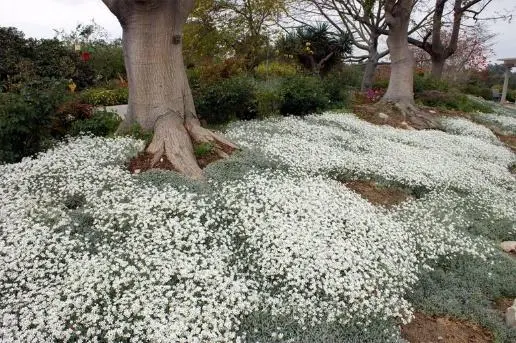
Bieberstein’s flowering sapling does not look like a carpet, but like unmelted snowdrifts
Stems creeping, stolon-shaped. Well rooted as soon as possible. The root system of Bieberstein’s hornfels is powerful, but horizontal. Located deep underground. It differs in that it easily penetrates into the smallest cracks in the stones. And on occasion, it can also contribute to splitting the rock.
Where grows
Bieberstein’s gossamer is a Crimean endemic that grows only in the mountains. Its natural habitat is yayla. The plant is a relic of the Tertiary period, which ended 1,8 million years ago.
Grow prefers on gravel-stony slopes and rocks. It can be found below the yayla, but always close to its border. Related to species whose range is:
- in Transcaucasia;
- in the mountainous part of the Balkan Peninsula;
- in Asia Minor.
In the photo, Bieberstein’s stalk is very similar to other members of the genus. But their growing conditions are different.
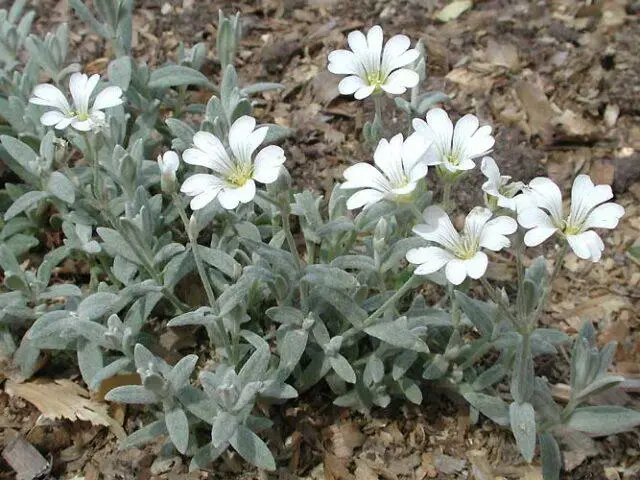
The popular name of Bieberstein’s sapling is the Crimean edelweiss, to which it is similar in color and shape of pubescent leaves.
Bieberstein’s hornfels are unable to withstand the harsh northern conditions. It is a relative of the southern species, the similarity with which indicates the connections of the Crimea and the Mediterranean in the distant past. However, in the wild, Bieberstein’s chickweed is not found anywhere except the Crimean Peninsula. Due to the rarity, it is listed in the Red Book:
- Ukraine;
- Europe;
- Crimea.
The range of Bieberstein’s hornfels as an ornamental plant is much wider. For acclimatization in other regions, the flower has been grown since 1945 on the botanical-geographic site “Crimea”, which was subordinate to the Central Republican Botanical Garden of the Academy of Sciences of the Ukrainian SSR. The seeds were obtained from the Nikitsky Botanical Garden, the rhizomes were collected during expedition trips to the Crimean Yayla.
The experiment was a success. In the Kyiv region, the Bieberstein sapling grew well without watering and actively bore fruit. Reproduction in this case was carried out by seeds planted in the ground before winter. The plant had a continuous growing season from spring to autumn. The life expectancy of one copy was five years. A special advantage was recognized as the very easy survival of Bieberstein’s hornfels when propagated by layering or division of rhizomes.
In culture, the sapling is used for carpet plantings in dry, well-lit places. That is, where other ground cover plants die or lose their decorative effect. Due to the leaves, Bieberstein’s hornfels remains attractive even after flowering.
Methods of reproduction
Bieberstein’s hornworm uses all possible methods for reproduction. This is typical for plants that live in harsh conditions. In the natural environment, hornfels can multiply:
- seeds;
- using stolon-like shoots.
When breeding in gardens, additional methods appear: cuttings, layering and division of rhizomes.
Growing Bieberstein’s stalks from seeds is the most time-consuming way. Seedlings require special “mountain” conditions and do not tolerate excess moisture. But after the difficulties of the first year, the grass is propagated in other, more effective ways. If there is no one to take planting material from, the seeds are worth the labor spent on them.
Spring is the perfect time to propagate Bieberstein’s hornfels by layering. You just need to wait until the new shoots reach a length of 15-20 cm. Since the stems of the grass are creeping and root easily, it often propagates by layering without permission. That is, to obtain a new bush, the owner does not even have to make an effort. And to guarantee rooting, it is enough to sprinkle the layers with earth. In autumn, a new plant can be transplanted to a permanent place.
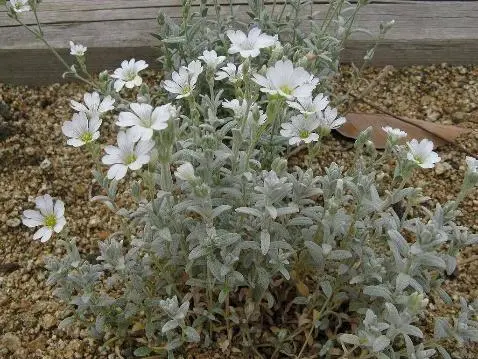
The transplanted Bieberstein’s stalk will take root better if the borders of the joints are covered from drying out
Cuttings are best done during flowering. If this is not possible, the procedure can be carried out earlier or later. Yaskolka will take root.
The shoot is cut off, excess leaves are removed from it and deepened into the soil. Here you need to strike a balance: it is impossible for the soil to be very wet or overdried. For better rooting, the cut stem is covered with a jar or a cut five-liter PET bottle, since the cutting needs a greenhouse effect. But you can root planting material in ordinary greenhouses.
The division of rhizomes is best done in the fall after seed maturation. Although the jaskolka is able to withstand the spring procedure. A horizontally located root system greatly simplifies the task. In fact, here it is necessary to cut the turf. Under part of the bush, the soil is carefully cut to a depth of about 20 cm. The separated stalk, together with the ground, is transferred to a pre-prepared place, carefully laid, squeezed and watered with water to crush the soil.
Planting and caring for Bieberstein’s chick
With all the difficulties of growing Biberstein’s hornfels from seeds, it is very popular with landscape designers. Overgrown curtains successfully mask landscape imperfections:
- hatches;
- slopes;
- boulders;
- unaesthetic areas of the garden.
But the sapling grows well not only in flower beds. It is often grown in pots and flowerpots. Although the plant has not been cultivated, a small amount of soil in flower containers does not bother her. She “equates” flower pots with hollows in rocks filled with earth. And uses this patch of soil to grow.
When to sow seeds
In open ground, seeds are sown before winter before frost or in April after the snow melts. The sprouted sprouts are thinned out, because due to the small size of the fruit, it is necessary to sow the sapling thicker than necessary. In the phase of the 2-3rd true leaf, the seedlings are thinned out, leaving a distance of 5 cm between them.
In the greenhouse for seedlings, seeds are planted in February-March. The resulting seedlings are sorted, since not all of them grow full-fledged. Transplanted to a permanent place in July.
Soil and seed preparation
Since Bieberstein’s hornfels was not subjected to selection, it requires the same conditions for growth as a wild-growing ancestor. Yayla is a plateau open to wind and sunlight. And the water is very bad. All reservoirs are below. The Crimean mountains are made of porous limestone, and the water that has fallen on the yayla almost immediately seeps down into the karst system of caves.
When growing the Crimean yaskolka, these nuances must be taken into account. The place for the flower bed is chosen well-lit. If there is no desire to “chase” the plant throughout the garden. Bieberstein’s hornfels, planted in the shade, will “crawl” itself to a lighted place, but it is unlikely that it will suit the owner of the site.
Partial shade is not bad for a chick, but in this case one should not expect luxurious “drifts”. Flowering will be relatively poor, although the plant will not die.
The soil is better to choose rocky. If you remember the yayla, then loam mixed with crushed limestone is best suited. Bieberstein’s sap grows well on poor soils, so you don’t have to worry about the nutritional value of the soil. But good drainage is essential.
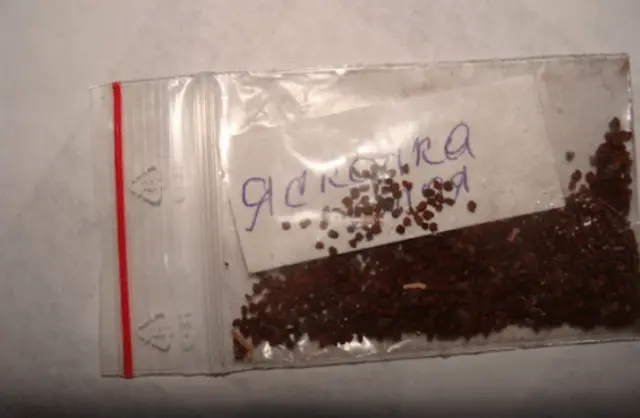
Due to their size, the seeds of the Bieberstein sapling are usually planted several at once in one hole.
Planting Bieberstein’s saplings for seedlings
For planting seeds for seedlings, a sandy loamy soil is prepared that passes water well. Carefully select containers. Moisture should not linger in them. Germination requires an air temperature of 20-25 °C.
Seedling care and planting in open ground
Seeds are planted in late February-April. Pots are placed in a sunny warm place. If the temperature is right in the greenhouse, containers can be placed there. Water no more than twice a week.
Seedlings are grown in portions: one container – one planting in the garden. Young sprouts do not dive, so as not to damage fragile roots. Under the open sky, a young sapling is planted in early June.
Aftercare
Planting Bieberstein’s stalks in open ground and subsequent care for it is much easier than growing seedlings. After transplanting the grass to a permanent place, it is lightly watered. In the future, the hornfels will need water no more than once every ten days.
A heavily overgrown curtain is cut. And use the cut parts as cuttings. Trimming the stems to force the stalks to bloom a second time is a bad idea. Bieberstein’s horn is cut once: immediately after fruiting, to give it a decorative look. The regrown grass looks decorative and is able to provide nutrients to the roots.
The aerial part of perennials helps the roots to gain nutrients for wintering and starting a new vegetative period. Excessive pruning weakens the root system. Repeat flowering will not be as abundant, and new stems will be weak.
Winter care yaskolka also does not require. She is able to endure the frosts of the Middle Strip without shelter for the winter. It is enough just to remove the dried stems.
Fertilizer and top dressing
Bieberstein’s Hornfel is able to grow in very poor soil. But do not refuse fertilizers. Jaskolka responds well to the introduction of organics: a solution of mullein after transplanting to a new place and during the flowering period. Grass and mineral fertilizers are suitable. However, experienced gardeners advise against fertilizing Bieberstein’s hornfels.
Diseases and pests
If the Bieberstein’s goat has natural enemies, then they live exclusively on the yail. As a garden crop, the plant is very resistant to pests and diseases. A fungal infection can affect Bieberstein’s hornfels in only one case: waterlogged soil. For snails, dry land is better than an abundance of moisture.
What plants are combined with
In landscape design, Bieberstein’s hole is used very widely. It is valued not only for its snow-white flowers, but also for its silvery foliage. On alpine slides and rockeries, it goes well with other inhabitants of alpine meadows:
- saxifrage;
- geyhera;
- stonecrop;
- bells.
The white flowers of Bieberstein’s hornfels well emphasize the brightness of the leaves of other plants. But in the company for the sapling, you need to select drought-resistant species.
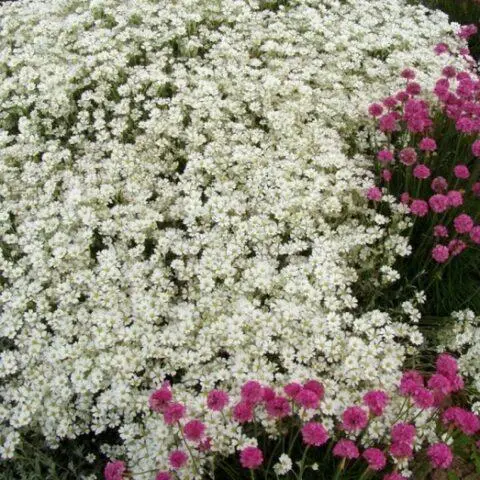
White “drifts” of Bieberstein’s shards well set off any other bright colors.
Conclusion
Bieberstein’s sapling is an original and unpretentious plant that can decorate any garden. Suitable for beginner gardeners, due to its endurance and good survival rate.









